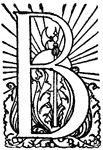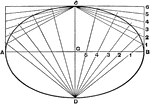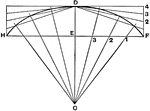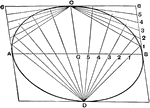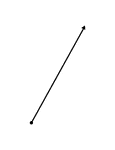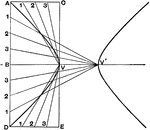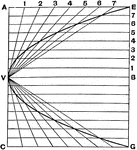
Ambulacra
"Ambulacra of Star-fish, As seen in a longitudinal and vertical section of one of the rays; and three…

Angelfish
"Notwithstanding its name is is a hideous-looking creature, with two enormous pectoral fins, said to…
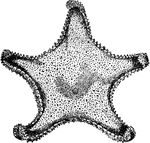
Astrogonium Phrygianum
"The rays are sometimes very short, or altogether wanting, the body having the form of a pentagonal…
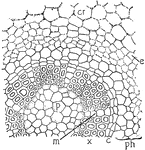
Botrychium
This illustration shows the cross-section of a stem of Botrychium: p, pith; x, xylem; m, ray; c, cambium;…
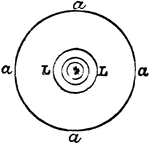
Catadioptric Holophote
"Catadioptric Holophote.—Part of the anterior hemisphere of rays is intercepted and at once parallelized…

Catadioptric Holophote
"Catadioptric Holophote.—Part of the anterior hemisphere of rays is intercepted and at once parallelized…
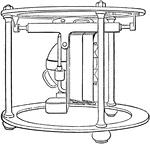
Condensing Apparatus
"Condensing Apparatus for Steamer's Side Lights.—By means of this application of the condensing…

Condensing Apparatus
"Condensing Apparatus for Steamer's Side Lights.—By means of this application of the condensing principle…
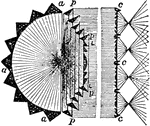
Condensing Light
"Fixed Conensing Light for a Single Sector, 1850.—The holophote Light pLp throws its whole light on…
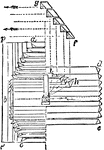
Condensing Octant
"Condensing Octant.—The central fixed apparatus bb with spherical mirror dd throws its rays directly…
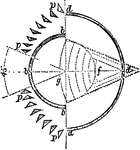
Condensing Octant
"Condensing Octant.—The central fixed apparatus bb with spherical mirror dd throws its rays directly…
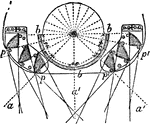
Condensing Quadrant
"Condensing Quadrant.—The fixed apparatus bbb, with spherical mirror behind, throws its rays directly…
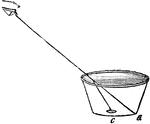
Cup and Shilling
"The refraction of water is beautifully proved by the following simple experiment. Place an empty cup,…
Lighting Fixture
A light fixture or luminaire is an electrical device used to create artificial light.
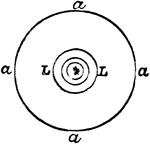
Holophotal Catadioptric
"Holophotal Catadioptric Apparatus Revolving round a Central Flame." —The Encyclopedia Britannica,…
Smooth Hound
"Noted for the smoothness of its skin; sometimes called Ray-mouthed Dog; takes bait, but is…
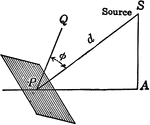
Illumination of a Surface When the Surface is not Perpendicular to the Source
Illustration modeling the illumination on a surface when the surface is not perpendicular to hte rays…

Curved Image
"If the object a be placed obliquely before the convex mirror, then the converging rays from its two…
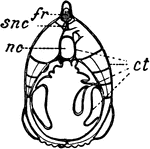
Section of a lancelet
"Section of Ampioxus, fr, fin ray; ct, connective tissue; nc, notochord, ; snc, supraneural…

Refraction of Light through Bi Convex Lens
"...let LN represent a glass biconvex lens, with centres of curvature at C and C', and AB, the incident…

Rays of Light
"Rays of light are said to diverge, when they proceed from the same point, and constantly recede from…

Reflection from Concave Mirrors
"Parallel rays of light strike the concave mirror. The rays converge at the focus, F, which is halfway…

Reflection by Convex Mirrors
"Parallel rays strike the convex mirror, reflect, and diverge as if they had originated from a virtual…
!["This will be understood [here] where the ray of light A B, proceeding from the eye, falls perpendicularly on the plane mirror B D. will be reflected back in the same line; but the ray C D coming from the feet, which falls obliquely on the mirror, will be reflected back under the same angle in the line D A; and since we see objects in the direction of the reflected rays, and the image appears at the same distance behind the mirror that is object is before it, we must continue the line A D to the feet, E, and for the same reason, the rays A B, from the eye, must be prolonged to F, as far behind the mirror as the line E extends, where the whole image will be represented." -Comstock 1850](https://etc.usf.edu/clipart/35800/35843/mirror3_35843_mth.gif)
Mirror Half the Length of the Object
"This will be understood [here] where the ray of light A B, proceeding from the eye, falls perpendicularly…
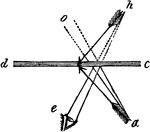
Plane Mirror
"Suppose the arrow a to be the object reflected b the mirror d c; the incident rays a, flowing from…
Moon Eclipse
"When the Moon falls into the shadow of the Earth, the rays of the Sun are intercepted, or hid from…
Prism
"A prism is a piece of glass, having for its sides three plane surfaces and for its ends two equal and…

Ray
A genus of cartilaginous fishes. They are generally divided into numerous families, including the saw-fishes,…
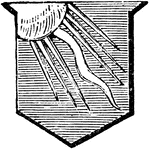
Ray of Sun
"Azure, a ray of the sun issuing out of the dexter corner of the escutcheon. The lines on each side…
Ray Pointing Down
A ray has one endpoint and extends indefinitely in the other direction. The ray in this illustration…
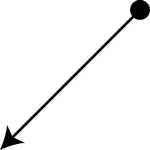
Ray Pointing Down and Left
A ray has one endpoint and extends indefinitely in the other direction. The ray in this illustration…
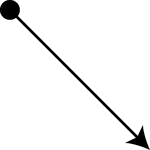
Ray Pointing Down and Right
A ray has one endpoint and extends indefinitely in the other direction. The ray in this illustration…
Ray Pointing Left
A ray has one endpoint and extends indefinitely in the other direction. The ray in this illustration…
Ray Pointing Right
A ray has one endpoint and extends indefinitely in the other direction. The ray in this illustration…
Ray Pointing Up
A ray has one endpoint and extends indefinitely in the other direction. The ray in this illustration…

Ray Pointing Up and Right
A ray has one endpoint and extends indefinitely in the other direction. The ray in this illustration…
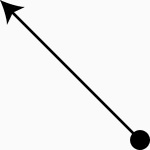
Ray Pointing Up and Right
A ray has one endpoint and extends indefinitely in the other direction. The ray in this illustration…
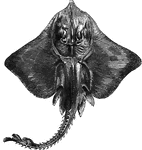
Bordered Ray
"Is two to three feet long, including the tail. The flesh is tolerably food, common on European coasts"…

Electric Ray
"It is remarkable for an electric battery situated between the pectorals and head and gills; this is…
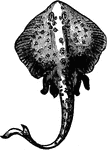
Starry Ray
The Starry Ray is so called for having a number of spines on its upper surface rising from rayed or…
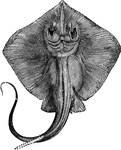
Sting Ray
"Its tail is arme with a sharp spine fives inches long, serated on both edges, with which it lacerates…
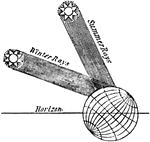
Rays
"Summer and Winter rays.—Let us suppose that the rays falling perpendicularly on a given extent…
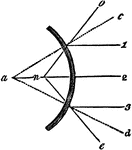
Divergent Rays
"From the surface of a plane mirror, parallel rays are reflected parallel; but the convex mirror causes…
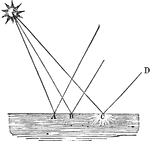
Reflection
"Here, of the rays S A, S B, and S C, only the ray S C meets the eye of the spectator D. The spot C,…

Angle of Incidence and Reflection
"Mirror A/B is only half of person C's height. C is able to view his entire body through such a small…
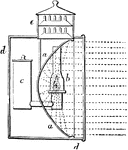
Parabolic, Reflector
A polished surface of metal, or any other suitable material, applied for the purpose of reflecting rays…
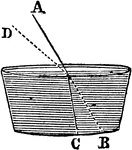
Refraction Between Mediums
"Since air is a rarer medium and water is denser, as ray A passes into the water, it is refracted to…
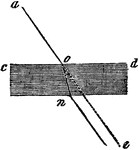
Refraction of Light
"Although a ray of light will pass in a straight line, when not interrupted, yet when it passes obliquely…

Refraction, air, water, glass
"Let a represent a, b water, and c a piece of glass. The ray d, striking each medium in a perpendicular…
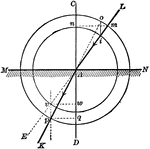
Refraction of Light Between Water and Air
"If the ray passes in the opposite direction, i.e., from water into air, the process is the reverse…
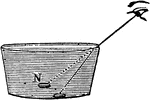
Refraction as seen by the Human Eye
"If the coin were to be observed in an empty pan and then watched as the pan was filled with water,…

Retina
"Diagram illustrating the points at which incident rays meet the retina. xx, optic axis; k, first nodal…
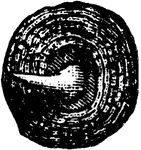
Placoid Scale of Ray
Fishes are sometimes classed, in accordance with the structure of their scale, into Ctenoid, Ganoid,…
